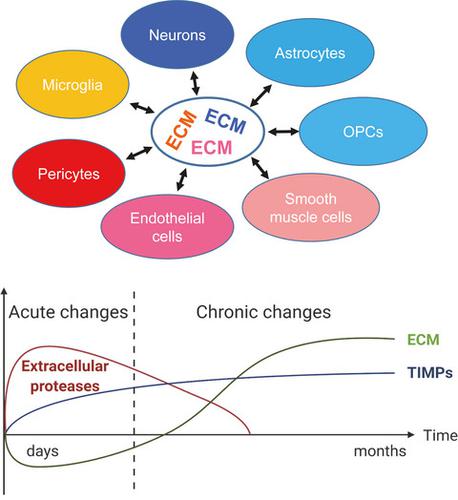当前位置:
X-MOL 学术
›
Eur. J. Neurosci.
›
论文详情
Our official English website, www.x-mol.net, welcomes your
feedback! (Note: you will need to create a separate account there.)
Interplay between perivascular and perineuronal extracellular matrix remodelling in neurological and psychiatric diseases
European Journal of Neuroscience ( IF 2.7 ) Pub Date : 2020-06-28 , DOI: 10.1111/ejn.14887 Philipp Ulbrich 1, 2 , Mahsima Khoshneviszadeh 1, 2 , Solveig Jandke 1, 2 , Stefanie Schreiber 1, 2, 3 , Alexander Dityatev 1, 3, 4
European Journal of Neuroscience ( IF 2.7 ) Pub Date : 2020-06-28 , DOI: 10.1111/ejn.14887 Philipp Ulbrich 1, 2 , Mahsima Khoshneviszadeh 1, 2 , Solveig Jandke 1, 2 , Stefanie Schreiber 1, 2, 3 , Alexander Dityatev 1, 3, 4
Affiliation

|
Vascular damage, central nervous system (CNS) injury, seizure or even psychological stress may trigger activation of microglia and infiltration of other immune cells, accompanied by high levels of expression and activity of extracellular proteases, such as matrix metalloproteinases (MMPs), and degradation/remodelling of the perivascular and perineuronal extracellular matrix (ECM). This acute response is followed by the recovery/chronic phase, during which the activation of astrocytes leads to the upregulated synthesis of ECM molecules, which, in combination with elevated expression of tissue inhibitor of metalloproteinases (TIMP) proteins, increases the aggregation of ECM molecules. This biphasic dysregulation of local balance between extracellular proteases and the ECM activates multiple temporally overlapping signalling cascades, involving receptor-type protein tyrosine phosphatases, integrins, Toll-like receptors, cell adhesion molecules, and ion channels, resulting in impaired synaptic plasticity and cognition. An additional level of complexity is related to the leakage of blood plasma proteins, such as fibrinogen, and the diffusion of perivascularly overproduced MMPs, TIMPs and ECM molecules into the CNS parenchyma, leading to diverse effects on neurons and incorporation of these molecules into the interstitial neural ECM. This review aims to outline these complex common mechanisms in stroke, CNS injury, depression, epilepsy, multiple sclerosis and cerebral small vessel disease and to discuss translational strategies to advance the development of new therapies for these neurological and psychiatric diseases.
中文翻译:

神经和精神疾病中血管周围和神经周围细胞外基质重塑之间的相互作用
血管损伤、中枢神经系统 (CNS) 损伤、癫痫发作甚至心理压力都可能触发小胶质细胞的激活和其他免疫细胞的浸润,同时伴有细胞外蛋白酶(如基质金属蛋白酶 (MMP))的高水平表达和活性以及降解/重塑血管周围和神经周围细胞外基质(ECM)。这种急性反应之后是恢复/慢性阶段,在此期间星形胶质细胞的激活导致 ECM 分子的合成上调,与金属蛋白酶组织抑制剂 (TIMP) 蛋白的表达升高相结合,增加了 ECM 分子的聚集. 这种细胞外蛋白酶和 ECM 之间局部平衡的双相失调激活了多个时间重叠的信号级联,涉及受体型蛋白酪氨酸磷酸酶、整合素、Toll样受体、细胞粘附分子和离子通道,导致突触可塑性和认知受损。另一个复杂程度与血浆蛋白(如纤维蛋白原)的渗漏以及血管周围过量产生的 MMP、TIMP 和 ECM 分子扩散到 CNS 实质有关,导致对神经元的不同影响以及这些分子掺入间质神经细胞外基质。本综述旨在概述中风、中枢神经系统损伤、抑郁症、癫痫、多发性硬化症和脑小血管疾病中这些复杂的常见机制,并讨论促进这些神经和精神疾病新疗法开发的转化策略。Toll 样受体、细胞粘附分子和离子通道,导致突触可塑性和认知受损。另一个复杂程度与血浆蛋白(如纤维蛋白原)的渗漏以及血管周围过量产生的 MMP、TIMP 和 ECM 分子扩散到 CNS 实质有关,导致对神经元的不同影响以及这些分子掺入间质神经细胞外基质。本综述旨在概述中风、中枢神经系统损伤、抑郁症、癫痫、多发性硬化症和脑小血管疾病中这些复杂的常见机制,并讨论促进这些神经和精神疾病新疗法开发的转化策略。Toll 样受体、细胞粘附分子和离子通道,导致突触可塑性和认知受损。另一个复杂程度与血浆蛋白(如纤维蛋白原)的渗漏以及血管周围过量产生的 MMP、TIMP 和 ECM 分子扩散到 CNS 实质有关,导致对神经元的不同影响以及这些分子掺入间质神经细胞外基质。本综述旨在概述中风、中枢神经系统损伤、抑郁症、癫痫、多发性硬化症和脑小血管疾病中这些复杂的常见机制,并讨论促进这些神经和精神疾病新疗法开发的转化策略。另一个复杂程度与血浆蛋白(如纤维蛋白原)的渗漏以及血管周围过量产生的 MMP、TIMP 和 ECM 分子扩散到 CNS 实质有关,导致对神经元的不同影响以及这些分子掺入间质神经细胞外基质。本综述旨在概述中风、中枢神经系统损伤、抑郁症、癫痫、多发性硬化症和脑小血管疾病中这些复杂的常见机制,并讨论促进这些神经和精神疾病新疗法开发的转化策略。另一个复杂程度与血浆蛋白(如纤维蛋白原)的渗漏以及血管周围过量产生的 MMP、TIMP 和 ECM 分子扩散到 CNS 实质有关,导致对神经元的不同影响以及这些分子掺入间质神经细胞外基质。本综述旨在概述中风、中枢神经系统损伤、抑郁症、癫痫、多发性硬化症和脑小血管疾病中这些复杂的常见机制,并讨论促进这些神经和精神疾病新疗法开发的转化策略。导致对神经元的多种影响并将这些分子掺入间质神经细胞外基质中。本综述旨在概述中风、中枢神经系统损伤、抑郁症、癫痫、多发性硬化症和脑小血管疾病中这些复杂的常见机制,并讨论促进这些神经和精神疾病新疗法开发的转化策略。导致对神经元的多种影响并将这些分子掺入间质神经细胞外基质中。本综述旨在概述中风、中枢神经系统损伤、抑郁症、癫痫、多发性硬化症和脑小血管疾病中这些复杂的常见机制,并讨论促进这些神经和精神疾病新疗法开发的转化策略。
更新日期:2020-06-28
中文翻译:

神经和精神疾病中血管周围和神经周围细胞外基质重塑之间的相互作用
血管损伤、中枢神经系统 (CNS) 损伤、癫痫发作甚至心理压力都可能触发小胶质细胞的激活和其他免疫细胞的浸润,同时伴有细胞外蛋白酶(如基质金属蛋白酶 (MMP))的高水平表达和活性以及降解/重塑血管周围和神经周围细胞外基质(ECM)。这种急性反应之后是恢复/慢性阶段,在此期间星形胶质细胞的激活导致 ECM 分子的合成上调,与金属蛋白酶组织抑制剂 (TIMP) 蛋白的表达升高相结合,增加了 ECM 分子的聚集. 这种细胞外蛋白酶和 ECM 之间局部平衡的双相失调激活了多个时间重叠的信号级联,涉及受体型蛋白酪氨酸磷酸酶、整合素、Toll样受体、细胞粘附分子和离子通道,导致突触可塑性和认知受损。另一个复杂程度与血浆蛋白(如纤维蛋白原)的渗漏以及血管周围过量产生的 MMP、TIMP 和 ECM 分子扩散到 CNS 实质有关,导致对神经元的不同影响以及这些分子掺入间质神经细胞外基质。本综述旨在概述中风、中枢神经系统损伤、抑郁症、癫痫、多发性硬化症和脑小血管疾病中这些复杂的常见机制,并讨论促进这些神经和精神疾病新疗法开发的转化策略。Toll 样受体、细胞粘附分子和离子通道,导致突触可塑性和认知受损。另一个复杂程度与血浆蛋白(如纤维蛋白原)的渗漏以及血管周围过量产生的 MMP、TIMP 和 ECM 分子扩散到 CNS 实质有关,导致对神经元的不同影响以及这些分子掺入间质神经细胞外基质。本综述旨在概述中风、中枢神经系统损伤、抑郁症、癫痫、多发性硬化症和脑小血管疾病中这些复杂的常见机制,并讨论促进这些神经和精神疾病新疗法开发的转化策略。Toll 样受体、细胞粘附分子和离子通道,导致突触可塑性和认知受损。另一个复杂程度与血浆蛋白(如纤维蛋白原)的渗漏以及血管周围过量产生的 MMP、TIMP 和 ECM 分子扩散到 CNS 实质有关,导致对神经元的不同影响以及这些分子掺入间质神经细胞外基质。本综述旨在概述中风、中枢神经系统损伤、抑郁症、癫痫、多发性硬化症和脑小血管疾病中这些复杂的常见机制,并讨论促进这些神经和精神疾病新疗法开发的转化策略。另一个复杂程度与血浆蛋白(如纤维蛋白原)的渗漏以及血管周围过量产生的 MMP、TIMP 和 ECM 分子扩散到 CNS 实质有关,导致对神经元的不同影响以及这些分子掺入间质神经细胞外基质。本综述旨在概述中风、中枢神经系统损伤、抑郁症、癫痫、多发性硬化症和脑小血管疾病中这些复杂的常见机制,并讨论促进这些神经和精神疾病新疗法开发的转化策略。另一个复杂程度与血浆蛋白(如纤维蛋白原)的渗漏以及血管周围过量产生的 MMP、TIMP 和 ECM 分子扩散到 CNS 实质有关,导致对神经元的不同影响以及这些分子掺入间质神经细胞外基质。本综述旨在概述中风、中枢神经系统损伤、抑郁症、癫痫、多发性硬化症和脑小血管疾病中这些复杂的常见机制,并讨论促进这些神经和精神疾病新疗法开发的转化策略。导致对神经元的多种影响并将这些分子掺入间质神经细胞外基质中。本综述旨在概述中风、中枢神经系统损伤、抑郁症、癫痫、多发性硬化症和脑小血管疾病中这些复杂的常见机制,并讨论促进这些神经和精神疾病新疗法开发的转化策略。导致对神经元的多种影响并将这些分子掺入间质神经细胞外基质中。本综述旨在概述中风、中枢神经系统损伤、抑郁症、癫痫、多发性硬化症和脑小血管疾病中这些复杂的常见机制,并讨论促进这些神经和精神疾病新疗法开发的转化策略。











































 京公网安备 11010802027423号
京公网安备 11010802027423号